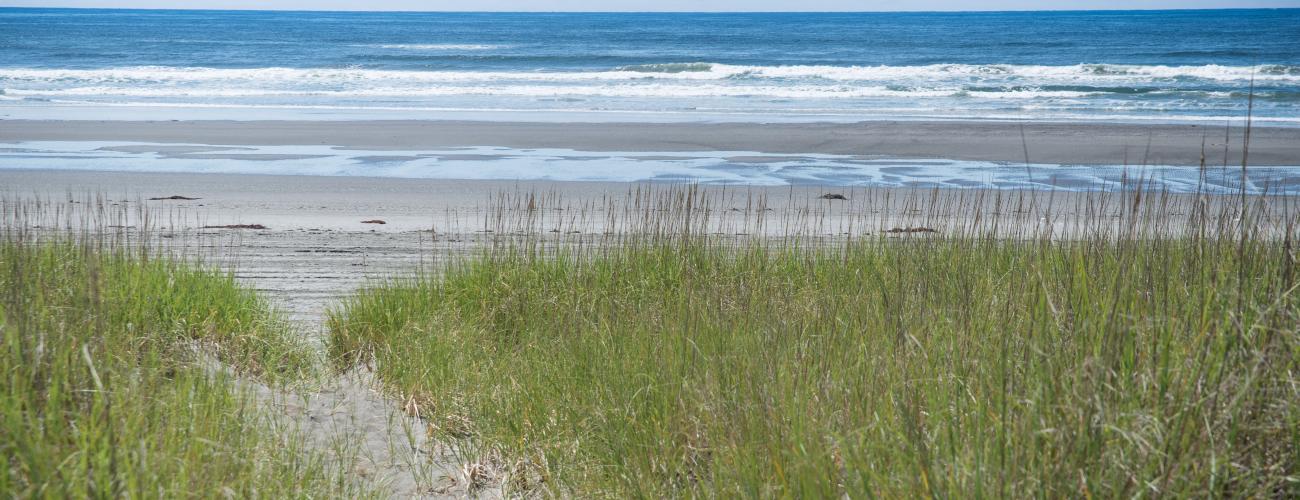Twin Harbors State Park History
Twin Harbors State Park gets its name from its location between the “twin harbors” of Grays Harbor and Willapa Bay.
Sand Dunes and Wetlands
Washington’s Pacific Ocean coast is a dynamic place! Massive volumes of sand and sediment are carried to the coast from deep in the interior of the state by the Chehalis, Columbia and other rivers and streams. Once sediments have emptied into the Pacific Ocean they are moved by waves and coastal currents. In winter months, sediments generally migrate parallel to the coastline. In summer months the sediments are pushed toward the shoreline, adding sand to the beach. Predominant winds from the southwest and southeast shape dunes parallel to the coastline. In areas of the dunes that have been stabilized by plant growth, depressions collect deep and poorly drained loamy sand that frequently floods in the wet winter months.
Modifications to the natural ebb and flow of sand on the coast have come from dams that trap sediment on the Columbia River, dredging of navigation channels at the mouth of the Columbia River and the entrance to Grays Harbor and the construction of jetties.
Indigenous Lands
The park lies within the traditional territories of Coast Salish Indigenous people whose present-day descendants include members of the Confederated Tribes of the Chehalis Reservation, Shoalwater Bay Indian Tribe and Quinault Indian Nation. For thousands of years this area has provided habitat for a diverse community of life that forms the basis of their cultures.
Local tribes refused to accept the conditions proposed by Washington Territorial Governor Isaac Stevens at the Chehalis River Treaty Council in February 1855. Subsequently, title to the land was relinquished to the US federal government and the Chehalis Reservation was established by executive order of Secretary of the Interior J. P. Usher on July 8, 1864. On September 22, 1866, President Andrew Johnson established the Shoalwater Bay Reservation by executive order.
Government surveys were completed in 1858 and land in today’s park passed into private ownership with Cash Entry Patents, a form of land sales from the public domain, in 1882 and 1884.
Grays Harbor Military Reservation
Camping by the Pacific Surf
The Washington State Parks Committee realized the demand and need for public recreation areas on the Pacific Ocean coast. The first parcel acquired for the park was the site of the military barracks, donated by Grays Harbor County in 1937. Though the property did not have beach frontage, the State Parks Committee acquired a 60’ right-of-way leading from the property to the beach from Daisy M. Benn, the daughter-in-law of the City of Aberdeen’s founder, Samuel Benn, in 1940, creating the first state park on Washington’s Pacific Coast.
After the December 7, 1941, attack on Pearl Harbor, US Army field artillery units from Fort Lewis were deployed to the reactivated Grays Harbor Military Reservation with field mounted guns. Again, some of the unit was housed at barracks on the Twin Harbors State Park property, and a searchlight was installed at the park’s beach access right-of-way. In April 1942, the park caretaker reported to the State Parks Committee that US Army personnel were cutting trees in the park, prompting the committee to consider selling the park property to the Army for its use. In April 1943, the State Parks Committee and Army signed an agreement setting terms for the use of the park.
Grays Harbor was not attacked during World War II, and the Harbor Defense was deactivated on January 8, 1944. The State Parks Committee purchased useful surplus items left at the site including pipe, stoves, electric wire, fire extinguishers and refrigerators.
The Washington State Parks and Recreation Commission purchased adjacent land on the shoreline from Daisy M. Benn in 1949 and improved recreational facilities in the park. A review of the park in 1956 noted “better-than-average campsites.”
Keeping Wetlands Wet and Campers Dry
The campground at Twin Harbors State Park, one of the largest in the state park system, has always experienced seasonal flooding due to the location of many campsites in the poorly drained interdune wetland depressions. More than 100 campsites have been closed due to fungal tree rot likely caused by flooding. Many others are unusable for much of the year due to standing water.
Park planners are working on designs for a more sustainable park, better suited to its geologic setting.
Sharing the histories of Washington’s state parks is an ongoing project. Learn more here.

